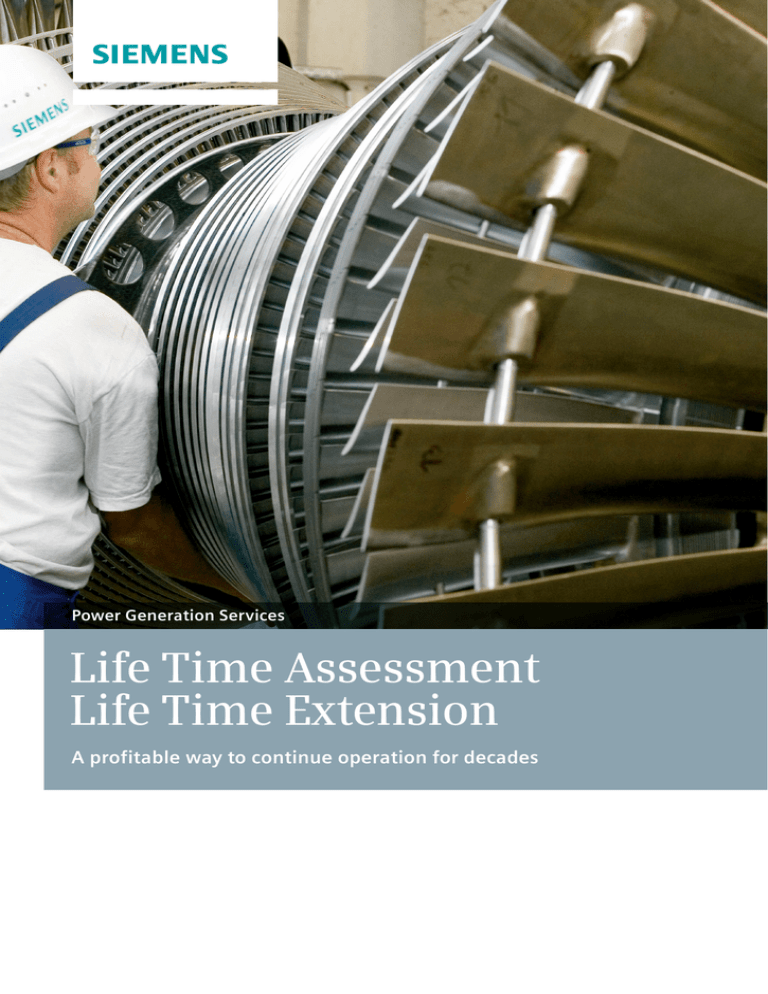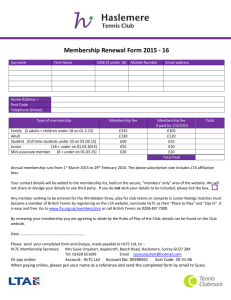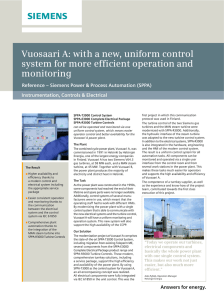
Power Generation Services
Life Time Assessment
Life Time Extension
A profitable way to continue operation for decades
General information
The driving forces behind Siemens Power Generation
Services is our dedication to speed of response and always
being close to the customer. This is because one of our
major goals is to deliver sophisticated services fast –
services that are designed to increase the lifecycle of your
plant’s assets, improve efficiency, and fit perfectly with your
plant’s performance needs and your business targets.
Our global network plays a central role in helping us meet
this commitment. With locations strategically positioned
across the globe, our close proximity to customers ensures
that Siemens’ vast resources and strong expertise are readily
available to provide customized and dependable solutions.
We are present in 178 countries worldwide and our 17
product competence centers and 25 service shops offer
world-class logistics to deliver fast and effective results.
Introduction
Aging steam turbines require your attention
An increasing number of industrial steam turbines are
operated beyond their design lifetime. Operating a turbine
for extended periods beyond the end of its normal design
lifetime may result in increasing failure risk and unplanned outages.
Each turbine is unique! Most of them are designed for
over 100,000 operating hours but their real life time
depends on
■■ Operation profile of the turbine
■■ Performed scope and intervals of maintenance
Depending on live steam parameters, mode of operation,
service conditions etc. certain damage mechanisms can
take effect, leading to deterioration of various components.
This can result in uncertainty about what measures should
be taken to meet your requirements for reliability and
availability, and when such measures should be carried
out from an economic point of view.
Siemens program for Life Time Assessment (LTA) and Life
Time Extension (LTE) is the structured way to secure operation beyond designed lifetime!
Failure risk
■■ Possible calculation margins.
Without LTA/LTE
With LTA/LTE
Design life time
Failure risk during turbine lifetime
2
Operating hours
Continuing profitable operation for decades
Reliable turbine operation is often of great importance.
The high investment cost and long delivery time of new
equipment make it worth considering the alternative of
LTE. The comprehensive LTA/LTE program available from
Siemens can help to secure future reliable operation of a
turbine approaching the end of its design lifetime. It is
recommended to perform Siemens LTA/LTE program latest
at 100 000 equivalent operating hours (EOH).
After careful investigation by our experienced engineers,
it could be possible to extend the operating life of the
turbine plant by tens of years at a limited investment cost.
In some cases the cost could be restricted to the inspection
cost only. In other cases, additional benefits can be gained
in performance or efficiency when replacing old parts
with modern equipment. This depends on the assessment
of our engineers in each individual case.
Mechanisms that limit component life
The real lifetime of turbine components depends on the
individual operating conditions and maintenance. The
three dominating factors of expected component lifetime
in high-temperature turbine plants are material creep, low
cycle fatigue and thermal aging. High temperatures combined with high stress levels accelerate damage to components such as steam piping, inlet valves, high pressure (HP)
turbine casings and rotors. At the exhaust end, corrosion
and erosion, combined with high stress, reduce the lifetime of low pressure (LP) turbine parts and heat exchangers. Similarly, electric generators are affected by thermal,
electrical, mechanical and environmental factors, which can
lead to lower output and efficiency as well as increased
failure risk over time. Water and steam chemistry are also
important factors affecting turbine lifetime. Impure steam
can, under specific circumstances, cause stress corrosion
and corrosion fatigue within a short period of turbine
operation.
Environmental factors
Stress
Temperature
Rotation
Flow
Stationary
Transient
Foreign objects
Creep damages in class 4b which
mean micro cracks with length
between 400 µm and 2 mm
Severe deposition due to impure
steam which mean a rough
surface finish and also a reduced
steam channel
Fatigue
Thermal degradation
Steam
Water
Corrosion
Moisture content
Broken inlet steam pipe due to
fatigue in a position exposed to high
temperature and a high stress level
Type of damage
Creep
Chemistry
Stress corrosion cracking in a rotor
operated with impure steam with
a high sodium hydroxide content
Depositions
Erosion
Failure mechanisms
3
LTA/LTE program
Siemens has developed a program for the Life Time
Assessment (LTA) and Life Time Extension (LTE) of
industrial steam turbines.
The program consists of three main parts:
LTA Desktop study, LTA and LTE.
General information
Result
Siemens has accumulated experience from thousands of
turbines operating all over the world. Material tests have,
for many decades, been conducted in our own laboratories.
Our engineers have wide ranging experience on the various techniques available for identifying critical components and assessing their remaining lifetime. The foundation is original design calculations updated with today’s
design criteria and when needed, complemented with
high technological FE-based calculation. The combination
of this experience and the bank of information available
within Siemens form the basis of the LTA/LTE program.
LTE
LTE
Recom
mendat ions
LTA
Experim
ental
LTA
LTA
Desktop
Study
Theore
tical LTA
Iden
critica tification o
l comp
f
onents
Settin
g the
Foun
d
ation
goals
,
rience
f expe
ears o inal design
Y
…
g
M
e
tabas
ns OE
rts, ori
Sieme nical expe material da
tech lations,
u
calc
LTA Desktop Study
A theoretical LTA Desktop study is the first step to take.
The output of such a study will be unit specific activities
for LTA and a suggested point in time for these activities.
The LTA Desktop study is recommended to be performed
about two years before reaching the second major overhaul according to Siemens maintenance program (after
100,000 EOH). Performing the LTA desktop study in that
early stage allows additional recommended measures
to the major overhaul to be implemented.
Step 1
Setting the goals
We sit down with you to define your technical and economic goals, taking into consideration future operating
conditions, output and availability. Preliminary cost estimates are made for lifetime extension on the basis of
these goals.
Step 2
Identification of critical components
A review of operating records, turbine history and design
calculations are made to identify critical components. You
as the customer are actively involved at this stage as well.
4
Setting the goals
LTA
Step 3
Step 4
Theoretical status and Life Time Assessment
Experimental status and Life Time Assessment
Components identified in step 2 will be further analyzed
in step 3. Complementary theoretical analyses are performed based on today’s design criteria and Siemens’
experience from similar units and components. To make
the inspections more focused, they might be preceded by
detailed temperature and stress analyses using
Inspection and non-destructive testing (NDT) of critical
components will be performed based on the LTA Desktop
study. Common activities are:
■■ Inspections
■■ Dimension checks
■■ Magnetic particle test, liquid penetrant test,
ultrasonic examination, eddy current inspection,
phased arrays inspection, etc.
■■ Hardness tests
■■ Replica extraction
■■ Surface sampling
In most cases the specified activities are enough for
a LTA, but in some cases more specific or even extended
NDT-activities are needed. In-depth analysis, like FE-based
calculations with modified material data or updated
performance calculations, might be necessary for evaluation of the results. Investigations continue only as far as
necessary to ensure the accuracy required.
FEM analysis of the turbine casing
FEM techniques. The assessment of remaining life time is
made by engineers, supported by long-term laboratory
tests and data from thousands of steam turbines in operation. All potentially critical components will be divided
into three classes from a conservative point of view:
Class 1:
■■ High priority
■■ Actions needed
■■ Risk for low reliability/availability/safety
■■ Limited lifetime
Evaluation of replicas in the laboratory. By analyzing the microstructure,
deviations such as creep damages or thermal aging can be detected at
an early stage.
Class 2:
■■ Operation time have exceeded the design
life time
■■ Long term actions
Class 3:
■■ No special action needed
■■ Normal inspection/maintenance
The output of this step is a conservative theoretical
Life Time Assessment and a specification of further
recommended LTA work.
Ultrasonic testing of bearings in the workshop
5
LTE
Step 5
Step 6
Recommendations for Life Time Extension
Life Time Extension
All information collected during the LTA work form
the basis of Siemens’ recommendation for LTE.
For each component, a unique recommendation
is specified:
A life time extension plan is established by executing the
recommended measures found in the LTA study. This means,
for example, that parts will be replaced, repaired or reinspected. The recommended LTE work will be updated
continuously and adapted to present customer needs.
■■ Return to service with no additional limitation
■■ Modify operating conditions
■■ Repair specific components
■■ Replace exhausted components
■■ Re-inspect at suitable time intervals
Sand blasting and repair works
Siemens has the knowledge!
Each LTA/LTE-work is unique due to different initial conditions: design, material quality, turbine history or vision
of the future. The deep knowledge and experience about
the wide range of aging turbines allows us to give well
founded recommendations. We continuously increase our
knowledge on aging turbines in the Siemens fleet by performing numerous annual LTA/LTE studies and longtime
destructive testing in our laboratory. By doing destructive
testing, it is possible for Siemens to investigate and analyze
material deviation and degradation through the components and compare the results with known parameters
such as:
■■ Original material structure
Valve casing divided into two halves to make internal inspection possible
■■ Operation temperature
■■ Operating hours
■■ Number of starts and stops
■■ Theoretical load level
A scrapped steam chamber from an old marine turbine used
for destructive testing
6
Case study
Turbine in a district heating plant
■■ In operation since: 1983
■■ Operating hours: 154,000 h
■■ Number of starts: 310
■■ Steam temperature: 540 °C/1000 °F
■■ Steam pressure: 114 bar/1650 PSI
The goal was set in step 1, the client wanted to secure
continued operation for at least 85,000 operating hours.
The customer focused on high availability and the intention
was continuous operation as long as possible, with the
turbine originally designed for 100,000 operating hours.
The results of the evaluation in steps 2-4, inspections and
complementary non-destructive testing, were that most
parts of the turbine were in good condition and the experimental status and LTA agreed with the theoretical. Further operation for 85,000 hours was considered possible
for most components. Serious creep damages were, however, found in the inlet emergency stop valve (ESV) and
the control valve (CV) casing. All cracks were grinded until
no indications were visible and further investigations and
inspections for LTE were recommended for the casing
within one year, step 5.
As part of the lifetime extension work, step 6, one year
later the ESV and CV casings were tested with a magnetic
particle test complemented by structure examination and
hardness measurements. At this time, the serious creep
damages had returned. The updated LTE recommendation
was now to plan for a replacement and to evaluate the
optimum operation manner to secure a low risk level until
a new valve casing was manufactured. Based on a fracture
mechanical calculation Siemens recommended turbine
operation with a decreased inlet temperature to minimize
further creep damages until the new casing were available.
After the old ESV and CV casing was replaced, the unit
had no limitation for further operation over the requested
period.
Potential benefits of LTA/LTE are:
■■ High availability and Reliability of a turbine
at the end of its design life
■■ Extension of the operating life of the turbine
at limited investment cost
■■ Performance and efficiency increase
7
Published by and copyright @ 2015:
Siemens AG
Power Generation Services Division
Freyeslebenstrasse 1
91058 Erlangen, Germany
Siemens Energy, Inc.
4400 Alafaya Trail
Orlando, FL 32826-2399, USA
Power Generation Services Division
Order No. E50001-E510-A247-X-7600
Dispo 34803
siemens.com
For more information, contact our
Customer Support Center.
Phone:+49 180/5 24 70 00
Fax: +49 180/5 24 24 71
(Charges depending on provider)
E-mail:support.energy@siemens.com
All rights reserved.
Subject to change without prior notice.
Trademarks mentioned in this document
are the property of Siemens AG, its affiliates,
or their respective owners.
The information in this document contains
general description of the technical options
available, which may not apply in all cases.
The required technical options should therefore be specified in the contract.


